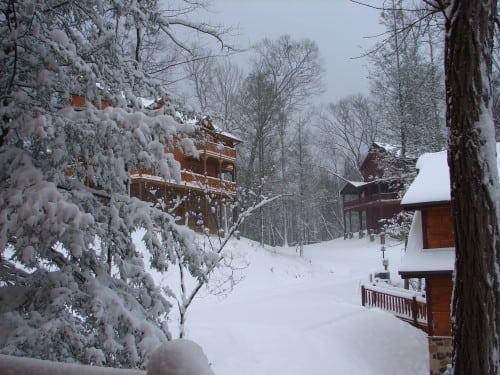Tips for Winterizing Rental Properties
Tuesday, November 25th, 2014
By: Steve Goldman, CCIM

Winter cabins at Elk Springs Resort in Gatlinburg, TN
Winter weather came early to East Tennessee this year! Hopefully, you didn’t experience any frozen pipes or other problems during the “arctic inversions.” As investors ourselves in multifamily and other residential rental properties, we thought we would share our favorite landlord tips for preparing your units — and your residents — for cold weather.
Winterizing Tips for Your Maintenance Team
- Disconnect, drain and store garden hoses. If there is a shut-off inside the crawl space or basement, close that valve and drain the line. Be sure to remove the hose and store it so someone doesn’t reconnect the hose and forget to disconnect it again.
- Winterize your irrigation system. Use the connections to blow out each line and then disconnect the back-flow preventer. This is usually done by your landscaper who has the proper size compressor to accomplish this.
- Service the HVAC units. It is wise to have each HVAC (Heating, Ventilation & Air Conditioning) unit serviced spring and fall. The fall checkup for gas units should include confirming that the heat exchanger is not releasing carbon monoxide (CO) into the living space and also that the vent is clear, such as of bird’s nests.
- Clean the gutters and check downspouts. Even if you have gutter guards, it’s a great idea to walk around each building during a heavy rain. Look for any water coming over the sides as well as leaks at the joints. Also inspect for water flow at the bottom of each downspout. Is it flowing away from the foundation? Do you need an extension, or should you pick up the water in an underground drain line? If you don’t have gutter guards, you should seriously consider the investment. Not only is it for leaves and pine needles but it also keeps other items from jamming up the water flow! Yup, we’ve seen drywall and carpet damage where the root cause was a t-shirt or a tennis ball clogging a gutter drain.
- Check the weather-stripping/caulking on each exterior door and window. It costs very little to replace a damaged or missing seal.
- Inspect for blocked or closed vents. Many times a tenant’s complaint of a cold room is simply that the supply vent is closed or blocked by furniture. A simple inspection and gentle suggestion may be all it takes to keep a happy renter!
- Ask the residents. Take a minute and ask the tenant if they notice any drafts. Again, it may cost very little to fix a simple problem — far less than the turnover cost of replacing an unhappy customer.
Winterizing Tips for Your Residents
Here’s a free tip sheet to send to your tenants in your monthly newsletter or notice:
Follow these tips to be comfortable and have the lowest expenses possible during the coming winter season.
- Windows. Sometimes residents leave windows open during the fall. Be sure to fully close and lock all of your windows. And if your unit has storm windows, simply raise your screens and lower the storm windows.
- Burned dust smell. The first time heating is turned on each year, it is common for there to be a smell for 10 minutes or so as dust gets burned off the heating elements. Just open a window for a few minutes. If it doesn’t clear up within 30 minutes, please call!
- Open your blinds during the day. If your windows are facing the sun, let the sunshine in and be nature’s heater!
- Change your air filter regularly.
- Look for any blocked or closed vents.
- Reverse the ceiling fan. If your unit has a ceiling fan, it’s time to reverse the direction to clockwise and put it on low speed. This will force the heated air to the walls and down, making the room more comfortable.
- If you feel cold air coming in doors, windows or electrical outlets, tell us! It may be a simple fix.
Back to Blog

